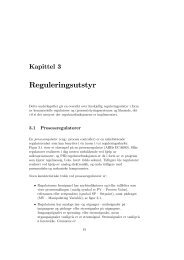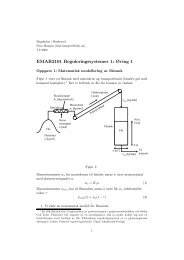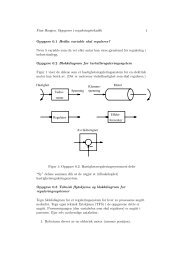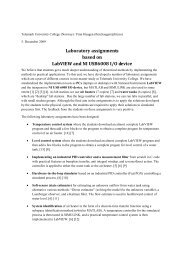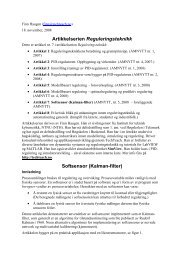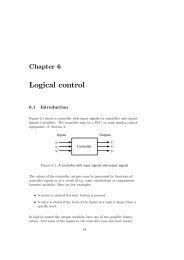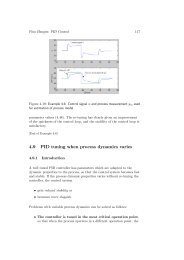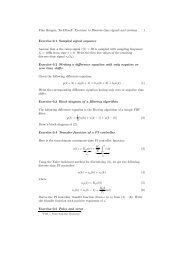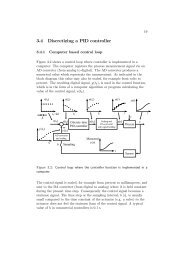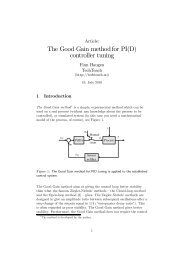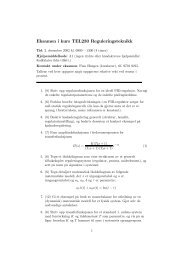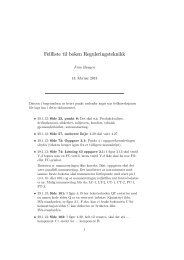Article: Ziegler-Nichols' Open-Loop Method
Article: Ziegler-Nichols' Open-Loop Method
Article: Ziegler-Nichols' Open-Loop Method
Create successful ePaper yourself
Turn your PDF publications into a flip-book with our unique Google optimized e-Paper software.
<strong>Article</strong>:<strong>Ziegler</strong>-Nichols’ <strong>Open</strong>-<strong>Loop</strong> <strong>Method</strong>Finn HaugenTechTeach17. July 20101 Introduction<strong>Ziegler</strong> and Nichols published in 1942 a paper [1] where they described twomethods for tuning the parameters of P-, PI- and PID controllers. Thesetwo methods are the <strong>Ziegler</strong>-Nichols’ closed loop method 1 , and the<strong>Ziegler</strong>-Nichols’ open loop method 2 . The present article describes theopen-loop method, while the closed-loop method is described in anotherarticle (available at http://techteach.no).<strong>Ziegler</strong> and Nichols [1] used the following definition of acceptable stabilityas a basis for their contoller tuning rules: The ratio of the amplitudes ofsubsequent peaks in the same direction (due to a step change of thedisturbance or a step change of the setpoint in the control loop) isapproximately 1/4, see Figure 1:A 2A 1= 1 4(1)However, there is no guaranty that the actual amplitude ratio of a givencontrol system becomes 1/4 after tuning with one of the <strong>Ziegler</strong> andNichols’ methods, but it should not be very different from 1/4.Note that the <strong>Ziegler</strong>-Nichols’ closed loop method can be applied only toprocesses where it is possible to read off an apparant time delay in thestep-response of the process to be controlled.2 The <strong>Ziegler</strong>-Nichols’ PID tuning procedureThe <strong>Ziegler</strong>-Nichols’ open loop method is based on the process stepresponse. The PID parameters are calculated from the response in the1 Also denoted the Ultimate gain method.2 Or the Process reaction curve method1
vtyy rA 1A 2tFigure 1: If A 2 /A 1 ≈ 1/4 the stability of the system is ok, according to <strong>Ziegler</strong>and Nicholsprocess measurement y m after a step with height U in the control variableu, see Figure 2. The term “process” here means all blocks in the controlexcept the controller. The step response experiment is executed on theuncontrolled process, so the control loop is open (no feedback).uu 0u 0+UtControlsignaluProcessincludingsensor andscalingProcessmeasurementy my my m0tFigure 2: The <strong>Ziegler</strong>-Nichols’ open loop method is based on the step responseof the uncontrolled processThe method is as follows.1. If the control loop is closed (i.e. feedback), the loop must be opened.This can be done by setting the controller in manual mode.2. Bring the process to the operation point by adjusting the controlvariable manually. This is done by adjusting u 0 in Figure 2.2
3. Excite the process via a step of amplitude U in the control variableu. The step should be “small” so that the process is not brought toofar from the operation point, but of course the step must largeenough to give an observable response in process measurement y m . Astep amplitude of U = 10% can be a reasonable value, but theamplitude must be chosen individually in each case.4. Read off the following characteristic parameters from the stepresponse in y m :• Equivalent dead-time or lag L• Rate or slope RFigure 3 which shows the relevant part of a typical step response. Inthe figure the time axis starts at the step time. The annotation “0.0”along the y-axis corresponds to y m0 in Figure 2. L is the time fromthe step time to the point of intersection between the “0.0”-line andthe steepest tangent. R is the slope of the steepest tangent.Figure 3: <strong>Ziegler</strong>-Nichols’ open loop method: The equivalent dead-time L andrate R read off from the process step response. (The figure is a reprint from[1] with permission.)5. Calculate the controller parameters according to Table 1.6. After the controller parameters have been calculated and entered intothe PID controller, the control loop is closed (by setting thecontroller in automatic mode).Eksempel 1 Controller tuning using <strong>Ziegler</strong>-Nichols’ open loopmethod3
Figure 5: Example 1: <strong>Ziegler</strong>-Nichols’ open-loop method applied to the woodchiptank6
Figure 6: Example 1: Time responses with PID parameters tuned using the<strong>Ziegler</strong>-Nichols’ open loop method7



